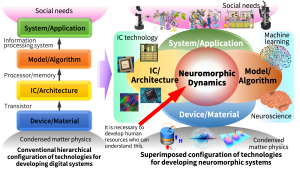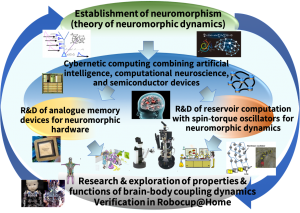This research project is commissioned by New Energy and Industrial Technology Development Organization (NEDO) (Project for Innovative AI Chips and Next-Generation Computing Technology Development/(2) Development of next-generation computing technologies), Japan.
AI technology represented by deep learning is coupled with Big Data and IoT to create highly functional artificial systems, and is promoting the sustainable, high-quality future symbiotic society of human and artificial systems. However, current deep learning to execute recognition and discriminant processing of sensor information such as images on a computer has several problems; 1) a large amount of data is required, and a task that requires quick reflex movements such as obstacle avoidance is difficult; 2) the processing capacity is highly dependent on the computer performance; 3) the improvement of energy efficiency is difficult. We believe that introducing the concept of neuromorphic computing based on a deeper understanding of the brain’s ultra power saving (about 20 W) and high-speed and advanced information processing mechanisms gives us hints for solving these problems. To that end, research and development based on the latest research in neurophysiology, theoretical research on modeling that enables engineering applications, and device development centered on hardware architecture for implementation is essential.
One problem in realizing them is the development system in which an individual’s goal has been set in each level of the development and technologies have been individually developed (left panel in the figure below). As a result, consistent issues and processes from device development to system application were not shared, and the computing method and hardware method were not defined. In this search program, we propose and share neuromorphism as a basic principle to solve this problem, and based on this, we construct “neuromorphic dynamics” area as a transdisciplinary field integrating related fields (right panel in the figure below). Neuromorphism captures the computational essence inherent in the neural and physical mechanisms of living creatures, and through its engineering realization, creates a new understanding of the neural mechanisms of biological systems, and feeds it back to engineering reproduction. It refers to the idea of a new interdisciplinary approach based on microscopic and macroscopic interpenetrating dynamical cycles of science and engineering.

In this search program, we construct a neuromorphic dynamics theory as a new principle of theoretical neuroscience and constructive computational neuroscience supporting neuromorphism. This includes issues such as neuronal spike activity, neuroplasticity, reservoir computing, as well as coupling with body dynamics. Then, based on this theory, we introduce a cybernetic computing method that links artificial intelligence, computational neuroscience, and semiconductor devices. In particular, we focus on the reservoir model that are promising as a computational model of the brain, and validate the reservoir hypothesis of the cerebral cortex. This hypothesis is that the brain acts as a reservoir of dynamics that generate complex spatiotemporal dynamics in response to input. We then explore the possibility of spintronics as a new device of reservoir computation. Furthermore, we will develop an analog memory device for neuromorphic hardware and a brain processing model that applies it. In addition, we will also consider the development of the robot’s body (soft robotics) that meets this kind of brain processing. We use RoboCup@Home, the application of daily life in the home of RoboCup competition, to verify the results of this project in the real world.

